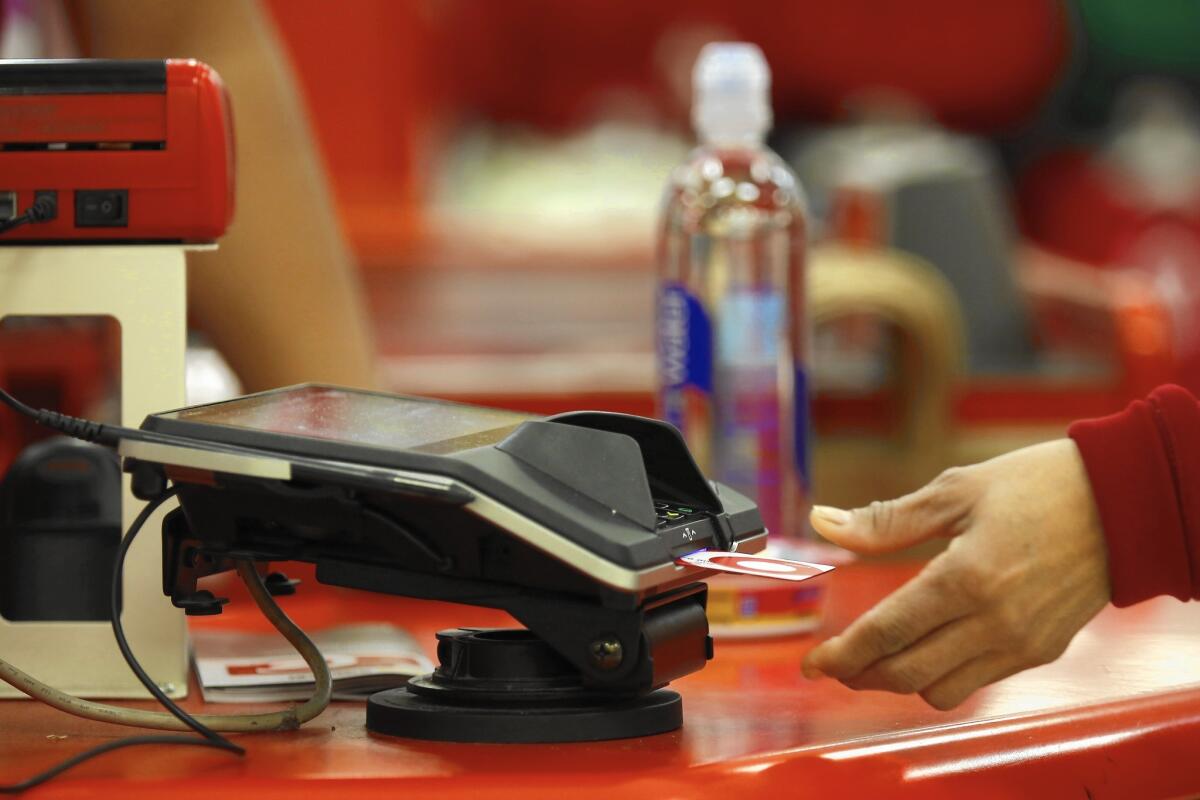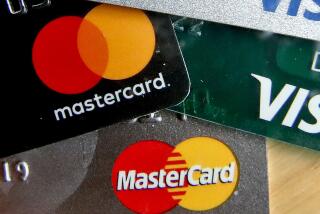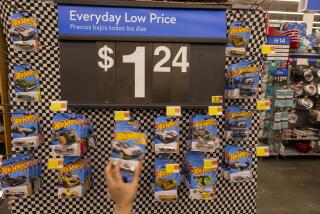Longer waits at the checkout counter? Blame credit cards with chip technology

Retailers are switching to credit card readers that handle those with chips. Wal-Mart, Home Depot and Target, above, are among those that have made the transition.
- Share via
It’s a few days before Thanksgiving, and so many shoppers have queued up that their carts are backed into the aisles at a Glendale Trader Joe’s.
Part of the checkout crush comes from the sheer number of people, several with baskets laden with fixings for Turkey Day feasts. But in a few lines, shoppers have had to insert their credit cards over and over again.
One man pulls his card out of the terminal too quickly, prompting the cashier to reset the transaction while covering the card slot to prevent any premature movements. Another woman smiles apologetically at the next customer in line as she repeats her transaction.
The holiday shopping season means waiting in line. But this year may be even worse. New chip technology in credit cards is making consumers’ purchases safer but also appears to be causing longer lines at some retailers.
The card with the tiny metallic square became more common after Oct. 1, which was when liability for covering fraudulent transactions shifted to the party that hadn’t adopted chip technology — either the merchant or the credit-card issuer.
For merchants, that meant ensuring their sales terminals had a slot to read the new cards, as well as the software to accept these payments. The American Bankers Assn. estimates that 70% of credit cards will be chip-enabled by the end of the year.
“I think what’s happening is just people are getting used to this change,” said Matt Schulz, senior analyst at CreditCards.com. “You have customers that are confused, you have people behind the counter that are confused, and you have a process that takes a little bit longer.
“You add all that up, and it leaves you with a little bit longer lines at retailers.”
The cards are designed to reduce counterfeiting by making it harder to create fakes using stolen data and easier for merchants to authenticate cardholders.
Instead of swiping a magnetic stripe, a customer inserts the card into the reader, chip end first. The card then stays in the reader until the machine OKs its removal.
Rebecca Mieliwocki, 47, of Glendale said she noticed that credit card transactions now take a little bit longer, but she doesn’t mind because of the chip’s added security.
“Relatively speaking, it’s not that much longer,” Mieliwocki said. “It takes a bit of getting used to, but it will be more than a few transactions before this becomes the norm.”
Although large retailers such as Wal-Mart Stores Inc., Target Corp., and Home Depot Inc. have already transitioned to the new technology, many smaller businesses are still upgrading, Schulz said. Full compliance on the merchant side won’t happen until 2017, when automated fuel dispensers are also required to have payment terminals that accept the chip card.
Security experts estimate that standard cards with a magnetic stripe will remain in circulation for years, and even chip cards still have the stripe on the back.
That can pose a problem in stores, where customers sometimes swipe their chip cards not realizing they need to insert them into the terminal.
“We expressed concern with the card companies about the idea of rolling this out over the holiday period,” said Mallory Duncan, senior vice president and general counsel for the National Retail Federation, a trade association. “Ideally if you’re going to do the training period, you should do it during January or February when there’s less traffic in stores.”
Some retailers say they aren’t seeing delays in their checkout lines, which they attributed to early rollouts of chip-card technology.
Wal-Mart spokesman Randy Hargrove said chip-enabled terminals were activated in stores in November 2014.
“Right now, there’s about a second difference between magnetic stripe transactions and insert-your-chip-card transactions, so they’re virtually the same,” he said.
All Target stores have accepted chip cards since mid-August, and the company’s REDcards also have the chip, company spokeswoman Molly Snyder said. She said the company hasn’t received guest complaints about transaction time.
“It does take a few additional seconds, but we’ve tried to streamline the process as much as possible,” Snyder said.
Home Depot finished its chip-card transition in September and conducted “significant training” with cashiers, spokesman Stephen Holmes said.
“As far as customers using it, it’s gone pretty smoothly,” he said.
A Trader Joe’s spokeswoman declined to comment. In stores, employees have been telling customers that the transition to the new cards is to blame for checkout delays.
To avoid the longer waits, Destiny Cervantes said she prefers to use cash or a debit card rather than her chip credit card.
“Sometimes I avoid it just because it takes a little longer,” said Cervantes,19. “When I do it wrong, it takes another whole minute for the next person to be next. It backs it up.”
Shoppers will get a lot of practice over the next month.
“The holiday season is going to be a crash course in how these things work,” said Schulz of CreditCards.com. “Over time, that issue is going to kind of lessen as people get used to it.”
Twitter: @smasunaga
More to Read
Inside the business of entertainment
The Wide Shot brings you news, analysis and insights on everything from streaming wars to production — and what it all means for the future.
You may occasionally receive promotional content from the Los Angeles Times.











